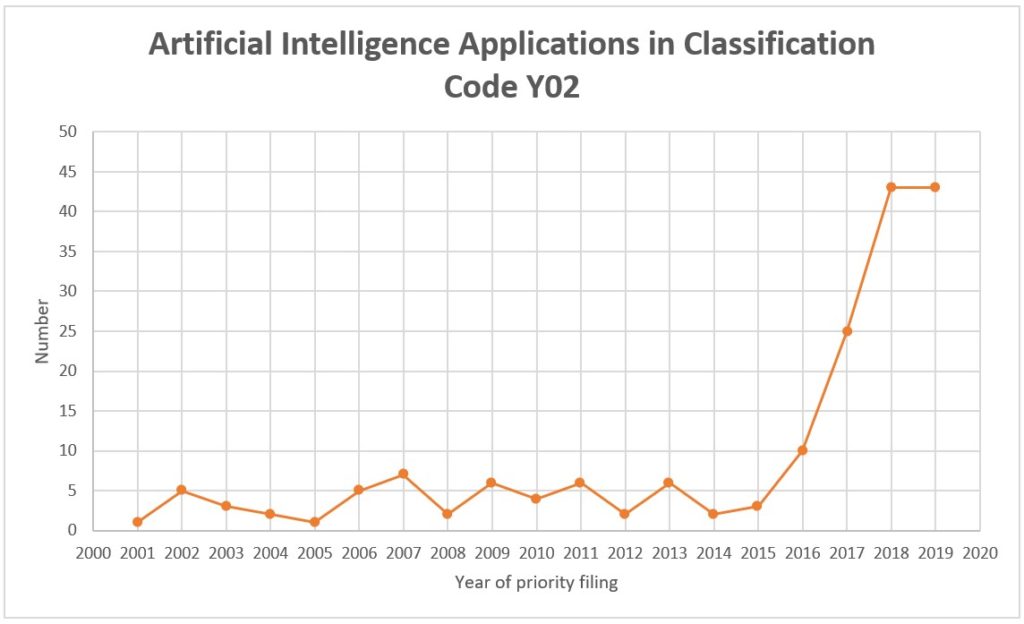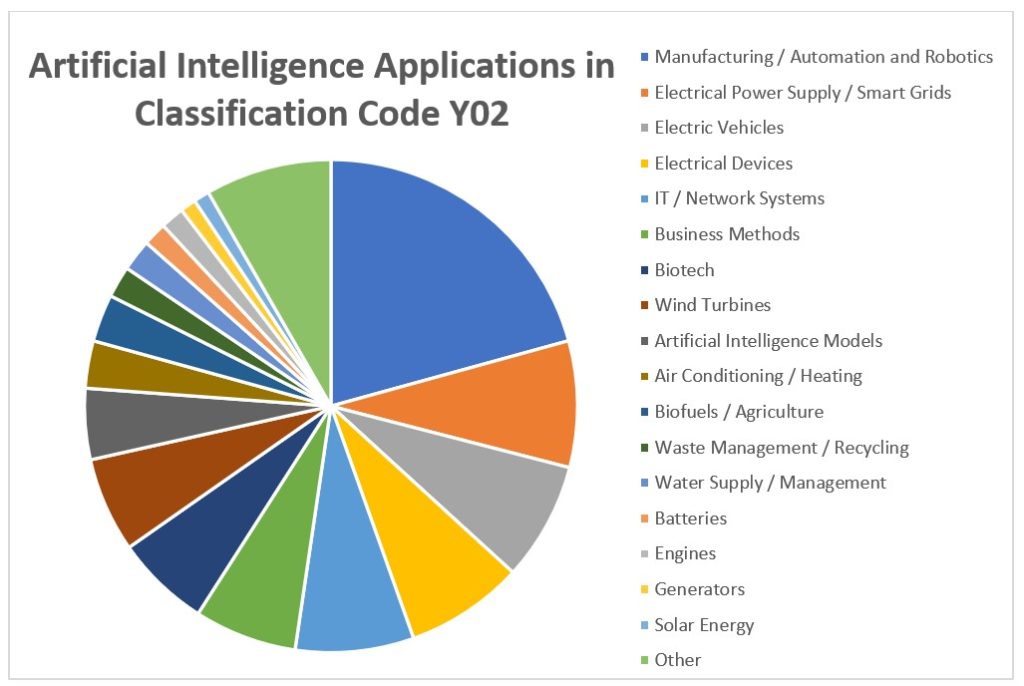31/05/2022
Two of the most popular topics at present are artificial intelligence (AI) and climate change. In this insight we explore the overlap between the two, particularly how AI can be applied to improve climate change combatting technologies, as well as reviewing aspects of several patent applications to highlight important considerations when seeking patent protection for such AI related inventions.
Innovation is on the increase
A quick search of the CPC classification code Y02: “technologies or applications for mitigation or adaptation against climate change” reveals that there have been approximately 200 European and UK patent applications in that classification that mention “artificial intelligence” in either the title, the abstract, or the claims. Although this a small data set, the evidence for increased innovation in the use of AI in climate change mitigating technologies is stark: 69% of these patent applications have been filed since 2016. The graph below shows the rapid increase in patent applications filed since 2016.

AI and cleantech
There are various ways that AI can be applied in cleantech fields. Examples include smart grids and network management, such as prediction of energy demand and managing supply from the diverse range of renewable and legacy energy sources connected to the power grid. The chart below gives a breakdown by topic of the patent applications in our data set.

To highlight some of the more important considerations in AI related patent applications in this field, we discuss a few examples selected from the data set above.
Each of the examples below are pending patent applications and the applicants are still negotiating claim scope and patentability with the respective patent office. Since it generally takes around 3-5 years for a patent application to proceed through search and examination to grant or refusal by the European/UK patent offices and the selected cases were filed after 2016, these patent applications may be granted. As discussed previously here, we regularly see evidence that patent applications relating to AI are being granted in Europe and the UK, and will continue to do so.
Example patent applications
EP3894964A1, filed by Siemens Gamesa Renewable Energy in 2019, relates to a “method and system for parameterisation of a controller of a wind turbine and/or operation of a wind turbine”.

The application discloses an AI that predicts the best operating parameters for a wind turbine, such as the braking torque or the pitch angles of the rotor blades, in order to provide the maximum power output at different levels of ice covering on the blades.
The description of the patent application includes few specific details of the AI itself, but instead treats the AI like a black box, that uses “machine learning, in particular reinforcement learning”. AI provides a way of predicting one or more outputs or outcomes from a given set of inputs. A typical application of AI is as a control mechanism. To be considered inventive, as discussed here, an invention will need to do more than apply a known AI algorithm and technique to an expanded data set of the type that a conventional, non-AI, control system would use. We therefore expect that as AI becomes ever more established across an increasingly diverse range of fields, successful AI-related patent applications will place an increased emphasis on the selection of the inputs, outputs and data processing in order to differentiate the prediction and control from that of conventional control systems. The European Patent Office is looking to associate a specialised AI examiner in each subject-matter area, and whilst there are examples of granted AI-related patents which seemingly describe little more than applying an AI for a new and useful purpose, we do not expect this to be case going forwards. With the rapid spread of renewable energy and the challenges it can create in achieving a stable energy supply, we expect that there will be many AI-related patent applications with the goal of optimising power production and supply under different environmental and operational conditions.

AI is already playing a large role in the next generation of clean and autonomous vehicles, and patent applications in this field are on the rise. An example is EP3769175A1 filed by Micron Technology Inc which describes using AI in a dynamic routing algorithm to identify the optimal route for an autonomous driving vehicle, taking into account the charge state and the rate of power usage. Its claims do not mention AI but describe using more detailed information than distance and road type usually included in routing a vehicle. This more detailed information is in the form of stress events (for example an angle of inclination of a route, an angle of curvature of a route, wind speed, rain severity, surface grade and depth of snow) which impact on power consumption and hence can be used to determine when a battery recharge will be required. There is no description of what sort of algorithm the AI is using nor any suggestion of the types and amounts of data used to train the AI. This suggests that the applicants do not see the invention as use of AI to determine the routing but rather in the realisation that using the stress events can improve routing for an autonomous vehicle. The description also discloses features such as optimising the speed of an autonomous vehicle along a route based on available power.
Another vehicle related application is EP3904138A1, entitled “Transmission Switching Mechanism For A Hybrid Vehicle”, which discloses an “onboard microcontroller with embedded neural algorithm to decide between the internal combustion engine and electric motor for propulsion”.

In the opinion accompanying the European search report for this patent application, the examiner has objected that although they could not find any prior art that destroyed novelty of the claimed invention, the application of an artificial intelligence to solve the problem of selecting a mode for a hybrid vehicle would be well known, amounting to a lack of inventive step. This follows the rationale of European Patent Office Board of Appeal cases T1191/19 and T161/18 in that the mere application of a neural algorithm to decide between the internal combustion engine and electric motor for propulsion is a general trend in technology and cannot be inventive as such. The application may disclose detail of the neural algorithm and its training which may yet be used as additional distinguishing features in the claims and which may form technical features to support an inventive step. The inclusion or absence of specific implementation details of the neural algorithm, for example its input data types, connectivity, depth and training, in the application as originally filed and the applicants willingness to restrict the claims to any disclosed details are likely to determine the outcome of this application.
When new features of an invention are not technical, they cannot be used in the determination of inventive step. In patent terms, image processing or controlling a physical system are considered technical and so using AI to perform image processing or using AI to control a physical system, such as adjusting a wind turbine, are also technical. However, a method of doing business is not considered technical and using a standard AI to carry out the business method, will not make the method technical. In patent application EP3731159A1 by Xendee Corp entitled “Adaptive Multiyear Economic Planning For Energy Systems, Microgrid And Distributed Energy Resources” the European examiner has objected that using AI for “economic planning” is not technical, and therefore the claimed invention lacks an inventive step. The applicant has amended the claims and is seeking to rely, amongst other things, on improved runtime of what amounts to a simulation to confer technical effect and support inventive step. This is a good strategy but may struggle because of insufficient evidence and detail of this aspect in the application.

A different type of invention lies in improving AI itself. Training AI often requires processing huge amounts of data which can be very power intensive. As AI becomes more prevalent in our daily lives, the amount of power used by super computers and data centres is likely to increase exponentially. Inventions seeking to reduce the energy demand of AI itself are therefore beneficial in the fight against climate change.
EP3895076A1 by Groq Inc is an application that relates to reducing power consumption of AI. In this application an AI algorithm is trained using parameters including power consumption data and performance data from previous processing of the AI model, to produce optimized parameters that reduce power consumption of the AI processor. This invention avoids the excluded subject-matter objection of being related to a computer program as such because it improves the way a computer system functions. Examination of novelty and inventive step is ongoing.
Summary
In selecting and discussing several patent applications relating to both AI and climate change mitigation, our aim was to highlight issues that can arise in the patenting process. When AI is involved as part of an invention, it is important to assess the contribution to the current technology and consider whether that contribution is technical in patent terms. If a decision is made to seek patent protection, careful drafting of the patent application is required.
The European Patent Office’s approach to AI inventions is as a subset of its approach to computer implemented inventions. Whilst there are almost always outliers to any established procedure, our view is that the EPO is generally applying its established case law consistently to AI related inventions whatever the field of application. We expect to continue to see an increase in core AI and AI-related patent applications and that this will flow through into a wider pool of granted patents in this subject-matter. If you need any help with an invention in the clean energy field and/or an invention involving AI, please do let us know – we have specialists on hand to help and often work in teams which cross conventional technical subject-matter divides.
This article is for general information only. Its content is not a statement of the law on any subject and does not constitute advice. Please contact Reddie & Grose LLP for advice before taking any action in reliance on it.



